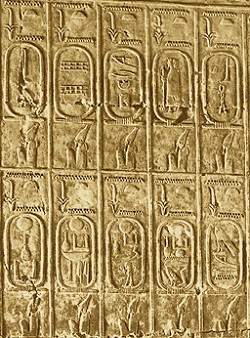
The period known as the New Kingdom includes the 18th Dynasty, the 19th Dynasty and the 20th Dynasty, ca. 1550 - 1080 BC. It starts immediately after the 2nd Intermediate Period, during which time the Hyksos ruled Egypt from the Delta. The first king of the 18th Dynasty, Ahmose, who came from Thebes, was able to banish them and to reunite Egypt. During the 18th Dynasty the kings were able to expand the boundaries of Egypt extensively. Large areas of Nubia, Syria-Palestine and elsewhere in the Near East were conquered; the economic situation in Egypt was very rosy. Most of the kings of this dynasty were called Tuthmosis or Amenhotep. Towards the end of this dynasty was the rule of Amenhotep IV or Akhenaten, who moved the residence to the newly built city of Akhetaten (El-`Amarna) and broke with religious tradition. His successors bear names such as Tutankhamun, Ay and Horemheb.
The 19th Dynasty was the time of kings called Ramesses and Sethos. The most famous is Ramesses II, whose campaigns against the Hittites are depicted on the walls of several temples throughout Egypt. The residence was moved to Piramesse in the Delta at this time. The 20th Dynasty, with a whole series of kings all called Ramesses, was mainly a time of unrest; foreign peoples such as the Libyans and the Sea Peoples threatened the borders of Egypt. There were also internal problems, however. While the kings ruled from the Delta, a civil war broke out in Thebes when the Viceroy of Nubia, Panehsy, clashed with the High Priest of Amun. Although Panehsy managed to penetrate Egypt far to the north of Thebes, he was eventually driven back to Nubia. Power was then seized by one of the generals in the Egyptian army, and the period known as 'whm-mswt' (the rebirth of Egypt after times of chaos) began. The kings of the New Kingdom were buried in the Valley of the Kings.